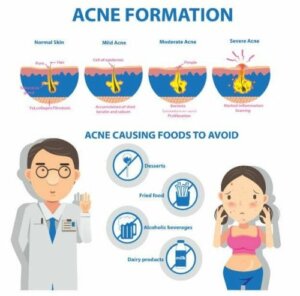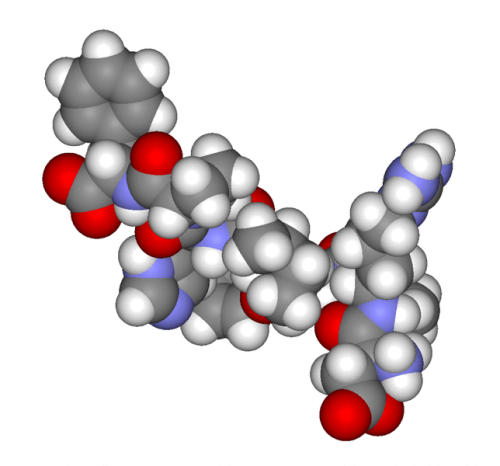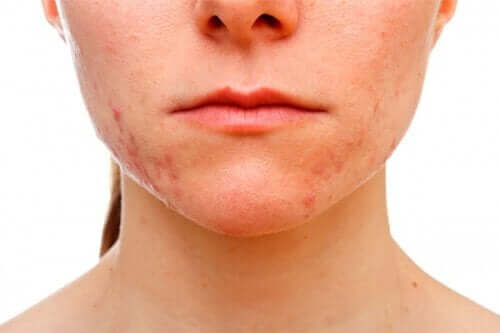Acne Conglobata: Causes and Symptoms

Acne conglobata is a chronic form of acne. It differs because it causes comedones, cystic nodules, fistulas, and abscesses, which lead to disfiguring scars.
This condition mostly affects men. It usually occurs between the ages of 15 and 25. Although it can appear on its own, it’s usually associated with patients who suffer from acne vulgaris. The lesions are located mainly on the face, neck, chest, and shoulders.
In this article, we’ll explain what it is as well as its characteristics.
What’s acne and acne conglobata?
Acne is an inflammatory skin disease. It’s one of the most common conditions in adolescents and young people. In fact, it’s the most common cause of dermatological consultation.
Specifically, it’s a pilosebaceous follicle disorder. The condition is multifactorial. Thus, experts believe that it’s caused by a combination of factors. For example, increased sebum production, secondary inflammation, and increased sensitivity to androgens, among others.

Acne lesions are comedones. However, they can evolve and become papules and pustules. In fact, even nodules and cysts can form. Therefore, there are different ways to classify acne:
- According to the age of appearance. It may be neonatal, infant, infantile, preadolescent, adolescent, and adult.
- According to the prevailing lesion. In this classification, we find comedonal, papular-pustular, or nodular-cystic acne.
- Mild, moderate, or severe, depending on the severity.
- Special forms: This is where we find acne conglobata.
Experts consider it a special form because it’s more severe. Acne conglobata tends to leave more extensive scars. Furthermore, its lesions extend beyond the typical areas where acne appears. In fact, it can affect the buttocks, abdomen, and armpits, among other areas. In short, it’s one of the most serious and chronic forms of acne.
This article may interest you: Fight Acne by Adding these 5 Detox Smoothies to Your Diet
The symptoms of acne conglobata
Mainly, the clinical picture is characterized by:
- Comedones, papules, and pustules
- Inflamed nodules and abscesses
- Pain in every lesion (Most lesions are very swollen. That’s why they hurt so much.)
- Ulceration
- Smelly discharge
- Skin damage and deformation
- Irregular scars (In fact, they can become hypertrophic and keloidal scars.)
Sometimes, acne conglobata appears along with blood disorders. For example, it can appear with anemia and leukocytosis. The lesions can be sterile or infected by some microorganisms. The most common bacteria is Propionibacterium acnes.
The physical symptoms are evident. However, we also have to mention the psychological impact of this condition. This is because acne conglobata can cause many self-esteem problems. Also, the patient may feel weak and insecure.
You may like this article: Try This Green Mask For Blackheads, Acne and Blemishes
Causes

As we mentioned above, acne conglobata has multiple causes. Contrary to popular belief, studies have shown that diet doesn’t directly influence its origin. The main triggers are:
- Increased sebum production. Similarly, it seems that its composition is also altered. Also, the sebaceous glands increase in size.
- Keratinization alterations occur. This leads to the formation of comedones, which is when altered sebum irritates the wall of the follicle. Keratinized cells flake and don’t fall off. Thus, they build up. This leads to the formation of a conglomerate of cells and oil, which is a comedon.
- The presence of Propionibacterium acnes. This is a bacterium that feeds on sebum. Thus, it proliferates more easily.
- Finally, an inflammatory process intervenes. Experts believe that this is due to both follicular erosion and bacteria.
Also, the appearance of acne conglobata is related to androgens. These hormones cause increased sebum production. The relationship is associated with different processes. Firstly, experts believe that increased sensitivity to androgens can lead to it. Also, it may be due to an unusually high level of androgens.
In fact, they’ve also observed that some factors worsen this acne, like sun exposure or stress.
Conclusion
Acne conglobata is a complicated condition. It causes very painful lesions that affect the patient’s life. This condition doesn’t only cause physical symptoms. In fact, it can affect the patient’s self-esteem and stability.
Therefore, it needs to be detected and treated in time, as this can reduce the incidence of scars and their severity. See a doctor if you are experiencing this skin condition.
All cited sources were thoroughly reviewed by our team to ensure their quality, reliability, currency, and validity. The bibliography of this article was considered reliable and of academic or scientific accuracy.
- Norris-Squirrell, F., & Pereira, M. (2017). Abordaje terapéutico de acné conglobata Acne conglobata therapeutic approach. Revista Mexicana Dermatologica, 61(4), 308–311.
- Acné conglobata: : Causas, Síntomas y Mejores Tratamientos para cada tipo – Unisima.com. (n.d.). Retrieved May 11, 2019, from https://unisima.com/belleza/acne-conglobata/
- Grant, R. N. R. (1951). The History of Acne. Journal of the Royal Society of Medicine, 44(8), 647–652. https://doi.org/10.1177/003591575104400802
- Gollnick, H. P. M., Finlay, A. Y., & Shear, N. (2008). Can we define acne as a chronic disease? If so, how and when? American Journal of Clinical Dermatology, 9(5), 279–284. https://doi.org/10.2165/00128071-200809050-00001
- Holland, D. B., & Jeremy, A. H. T. (2005). The role of inflammation in the pathogenesis of acne and acne scarring. Seminars in Cutaneous Medicine and Surgery, 24(2), 79–83. https://doi.org/10.1016/j.sder.2005.03.004
This text is provided for informational purposes only and does not replace consultation with a professional. If in doubt, consult your specialist.








